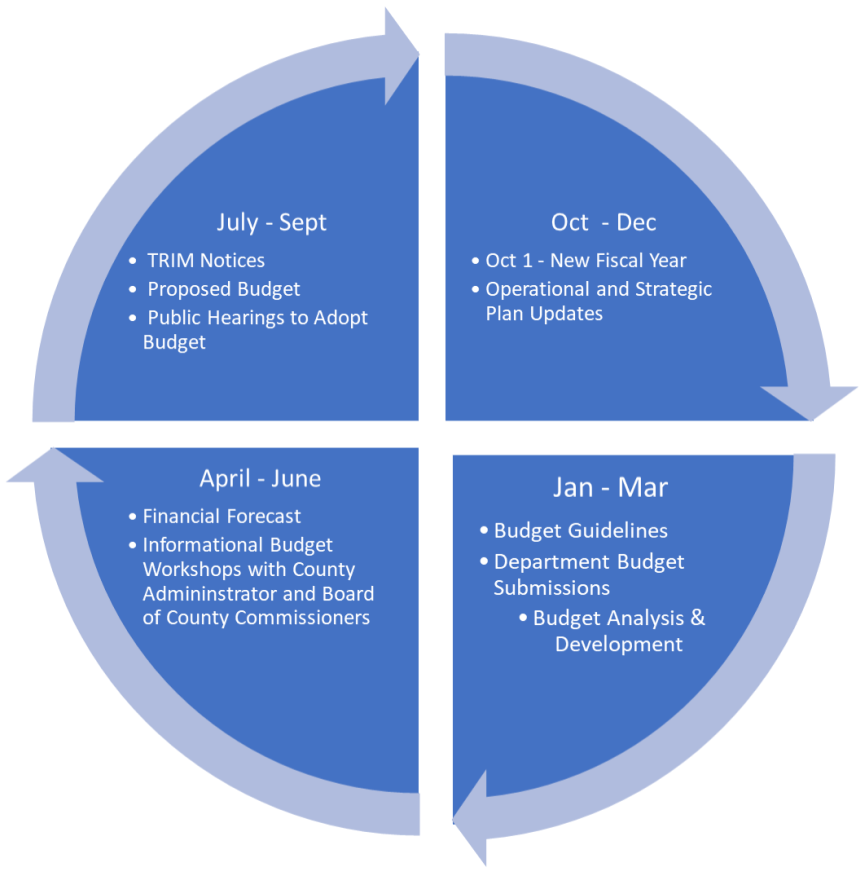Budget Process
The annual budget process is a year-round process as shown in the Budget Process Overview graphic below.

Refresh Strategic Plan
January
At the beginning of the calendar year, the Board of County Commissioners refreshes its Strategic Plan. This allows departments to build their budget requests to align with the refreshed Strategic Plan.
To help inform the Board before their strategic planning workshop, departments may present a report of their ongoing and newly developed tactics, projects or programs that link back to the Strategic Plan. This process helps departments and agencies under the Board link the various projects and programs funded in the Annual Budget to the five goals of the Strategic Plan, ensuring that sound strategy is linked to the big picture driving budget decisions.
Financial Forecast
January/February
After the fiscal year starts, the initial step in the annual budget process is to update the financial forecast, which is based on available information and forms the underlying basis for developing the strategy to balance the budget.
The forecast is built upon an individual assessment of 10 of the County’s major funds: the General Fund, the Tourist Development Fund, the Transportation Trust Fund, the Capital Projects Fund, the Emergency Medical Services Fund, the Airport Fund and the Water, Sewer, Solid Waste and Surface Water Funds.
Developing the forecast requires updating the projections for the prior fiscal year with actual revenue and expenditure information following the year-end closeout. Current fiscal year revenues and expenditures are projected on a preliminary basis by analyzing the actual year-to-date numbers and projecting the remaining months left in the fiscal year. These projections are further refined later in the process as departments provide their projections for revenues and expenditures.
The “out-years” (additional 5 years) are forecasted using various projection methods such as trend analysis, linear regression and moving averages. Developing a multi-year forecast provides decision-makers with key benefits, such as:
- Assessing the long-term financial sustainability of the County’s funds.
- Understanding the impact of today’s decisions on the future.
- Providing a holistic financial picture.
Targets/Budget Guidelines
February
The targets or budget guidelines are developed by County Administration based on the financial forecast. These are communicated to the County’s departments and agencies to assist with their budget development. All instructions and resources for preparing budget requests are also distributed.
Budget Submissions
March/April
County departments and agencies submit their completed budget submissions in March and April, except for the Constitutional Officers who have a due date of May 1. The budget submissions are analyzed by the Office of Management and Budget in preparation for budget work sessions with the Board.
Budget Work Sessions
April/May/June
Various budget work sessions are held with the Board to obtain feedback necessary to develop the Proposed Budget, such as millage rate policy, proposed program enhancements or reductions and revenue adjustments.
Proposed Budget
July
The Proposed Budget is prepared by the County Administrator based on direction gathered from the various budget work sessions with the Board and priorities in the County’s Strategic Plan. The Proposed Budget document presents a balanced budget for the coming year.
Public Hearings to Adopt Budget
September
Once the Proposed Budget is distributed, additional budget work sessions may be held to provide further guidance to the County Administrator. All changes to the Proposed Budget are finalized and announced at each of the public hearings. The public hearings are an opportunity for citizens to provide input to the Board regarding the budget process.
At the first public hearing, the Board approves the tentative millages and budgets. At the second public hearing, the Board approves the adopted millages and budgets.
Adopted Budget
October
The new fiscal year begins on October 1 based on the Adopted Budget, and the annual budget process ends.
For specific dates applicable to the current budget process, see the Budget Timeline.